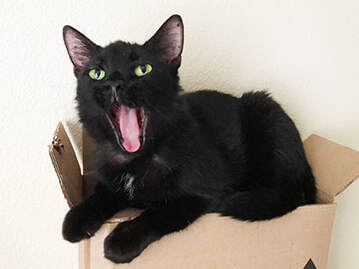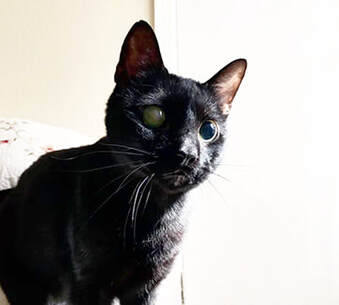
If your kitty’s breath seems less than fresh lately, there are various reasons behind it, the most common being periodontal disease.
An inflammation of the tissues surrounding your cat’s teeth, it’s caused by the buildup of plaque and tartar, rife with large amounts of bacteria that release malodorous sulfur compounds. Treating this condition requires professional removal of the plaque and tartar under anesthesia in a vet’s office. Maintaining her newly cleaned teeth requires regular and conscientious dental care at home and twice yearly dental exams from then on.
Abscessed tooth roots are also common. The infection produces pus that drains around the affected tooth and into your cat’s mouth, and as the abscess grows, the side of her face closest to the site will start to swell. Sometimes the infection will even break through her skin and the pus will leak onto her fur. An abscess must be lanced and drained by a vet, and more often than not, the affected tooth extracted, and your cat placed on antibiotics for several days.
Respiratory viruses are common as well. One of them, the calicivirus, often causes ulcers to appear on a cat’s tongue. While they have a foul smell, most cats recover swiftly from these infections, and once the ulcers heal, the smell disappears.
The most worrisome cause of feline halitosis, however, is an oral tumor, with squamous cell carcinoma being the most common. As the tumor grows, parts of it may become infected and start to decay, resulting in an unpleasant odor. Most cats with oral tumors have a poor prognosis. Why? Because by the time they start exhibiting signs of a problem inside their mouths, the tumor has already infiltrated too extensively, making treatment impossible.
Bad breath can result from non-oral conditions as well.
As cats age, their kidneys begin to weaken, impairing their ability to filter toxins from their bloodstream. The further this condition progresses, the higher the level of toxins, leading them to develop uremia (the term literally means urine in the blood). Cats suffering from uremia usually have extremely foul or “rotting” breath and often develop ulcers on the sides of their tongues that make their already bad breath even worse.
Diabetes can also negatively impact a cat’s breath. While some diabetic cats have that telltale sweet, fruity smell to their breath, the more obvious signs that something’s amiss are increased thirst, increased urination, and noticeable weight loss despite an increased appetite.
Given the various medical conditions that can cause halitosis, always err on the side of caution and have your cat examined by your vet if she fails the “smell test.” To determine its underlying cause if one isn’t patently obvious, the vet will take kitty’s complete health history, perform a physical exam and, more often than not, order blood tests and a urinalysis, and any other diagnostic tests deemed necessary.
As with the majority of medical issues, though, the best way to “treat” a problem is to prevent it in the first place. And since periodontal disease is the most common cause of feline halitosis, your primary line of defence is a dedicated dental home care routine. This includes brushing your cat’s teeth regularly using a feline-specific toothpaste, starting slowly and rewarding her with positive reinforcement. If this proves too difficult, wiping the outside of her teeth and gums with a Q-tip twice a day is one of the most effective ways of removing and slowing the accumulation of plaque. Last, but certainly not least, feed her a diet that’s especially designed to reduce plaque and tartar buildup, and give her dental treats – using only those products recommended by the Veterinary Oral Health Council.










 RSS Feed
RSS Feed